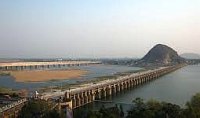Mention the flood management initiatives of government of India. Is India well prepared for mitigating its effects?
Civil Services Main Examination
General Studies (Paper - 1) : Model Question & Answers
 Question:
Mention the flood management initiatives of government of India. Can we say
India is well prepared for mitigating the ill effects of future floods?
Question:
Mention the flood management initiatives of government of India. Can we say
India is well prepared for mitigating the ill effects of future floods?
Flood Management: Need for Storage Dams
-
Like water scarcity, floods have substantial economic impacts.
-
Floods being a natural phenomenon, flood management measures mainly deal with mitigation rather than total elimination.
-
Thus the main characteristic of India’s water resources is its uneven distribution in space and time leading to endemic and sporadic problem of water shortages and excesses.
Problems of floods and drought
-
Two third of the water resources is contributed by the Ganga- Brahmaputra- Meghna river basin covering one third of the geographical area of the country.
-
Over 80-90 percent of the run-off in the Indian rivers occurs in the four monsoon months of June to September resulting in creating regions of harmful abundance of water during the monsoons.
-
Frequent occurrence of floods and drought is a reflection of our failure to develop and manage our water resources.
Flood control and management: Past attempts
National Flood Management Programme
-
Launched in 1954, different methods of flood protection structural as well as non-structural have been adopted in different states depending upon the nature of the problem and local conditions.
-
Structural measures include storage reservoirs, flood embankments, drainage channels, anti-erosion works, channel improvement works, detention basins etc. and non-structural measures include flood forecasting, flood plain zoning, flood proofing, disaster preparedness etc.
-
Since then more than 35,000 km of embankments has been constructed and more than 39,000 km of drainage channels improved which could absorb and regulate peak floods when necessary.
Rashtriya Barh Ayog (National Flood Commission) 1976
-
It was set up by government of India to evolve a coordinated, integrated and scientific approach to the flood control problems in the country and to draw out a national plan fixing priorities for implementation in the future.
-
Major recommendation made by RBA includes flood plain zoning and management to regulate man made activities.
Regional task forces 1996
-
It was set up to review the impact of the recommendations of the RBA and to suggest short term and long term measures
-
Their measures included among other administrative measures, construction of large flood moderation projects, particularly in the North- East and following up the enactment of Flood Plain Zoning Act so as to tackle encroachment by people in the flood plains.
National Commission for water resources 1999
-
It had also observed that storage dams and embanks provided effective protection to large flood prone areas.
-
It also suggested the urgent need to enact flood plain zoning act.
National water policy 2012
The objective of the National Water Policy is to take cognizance of the existing situation, to propose a framework for creation of a system of laws and institutions and for a plan of action with a unified national perspective.
It had suggested that reservoir operation procedures should be evolved and implemented in a manner so as to have flood cushion and to reduce trapping of sediment during flood season.
It has suggested incorporatecoping strategies for possible climate changes, such as increasing water storage capacity in dams.
Flood Control and Moderation by Storage Dams
-
Storage dams areonly meantfor flood control.The planning would be to maintain a low reservoir level during high flow months and use the storage capacity to absorb the incoming flood peaks.Soon after a peak passes down, the reservoir is brought down at a controlled rate to the low level to be ready to face the next flood. Such projects would not be usually economically justifiable.
-
Multipurpose projects are basicallyfor irrigation and power benefits. They could be planned to also include moderation benefits as well, storing water for the non-monsoon period.
Major projects providing flood control benefits
This progamme which provided flood control benefit are dams of Damodar Valley Corporation (DVC), the Hirakud Dam on the Mahanadi , Ukai dam on the Tapi and the Bhakra Dam across Sutlej.
-
Hirakud Dam:A major earth cum masonry dam across Mahanadi River.
-
Damodar Valley Corporation: a series of four dams on the Damodarand Barakar rivers,namelyKonar, Maithon, Panchet and Tilaiya.
-
Ukai dam: TapiRiver
-
Bhakra Dam:Sutlej River
-
Tehri hydro project:Bhagirathi River
-
SardarSarover Project: on the Narmada River
Conclusion: It is feasible to provide a certain degree of protection against floods in terms of reduced frequency and flood damages by having storage dams across major riverswhich are able to absorb the peak flood and to regulate the flows downstream into river.Apart from storage dams the country also has to focus its strategy to have efficient management of flood plains, flood plains, flood proofing including disaster preparedness and response planning including flood forecasting and warning and other non structural measures such as disaster relief, flood insurance etc to mitigate the miseries caused by floods.
data-matched-content-ui-type="image_card_stacked"
Useful Tips & Articles
तैयारी कैसे करें? |
EXAM SUBJECTS |
STUDY RESOURCESDownload Free eBooks |



